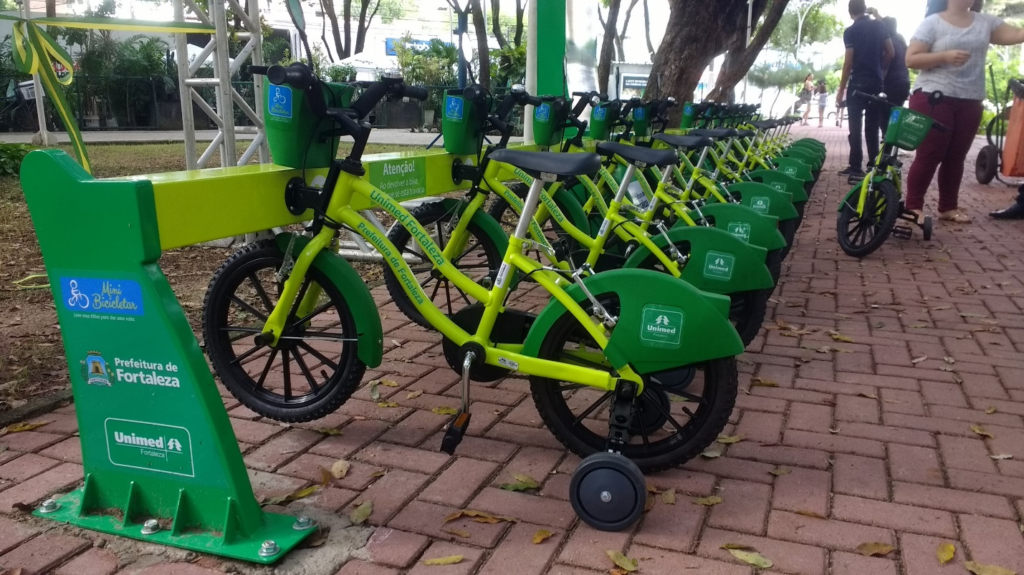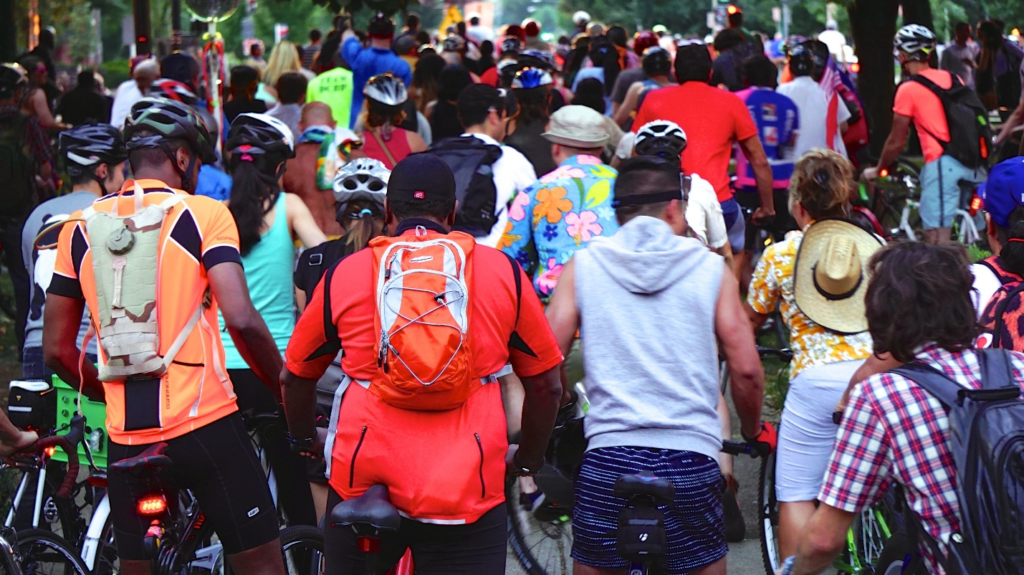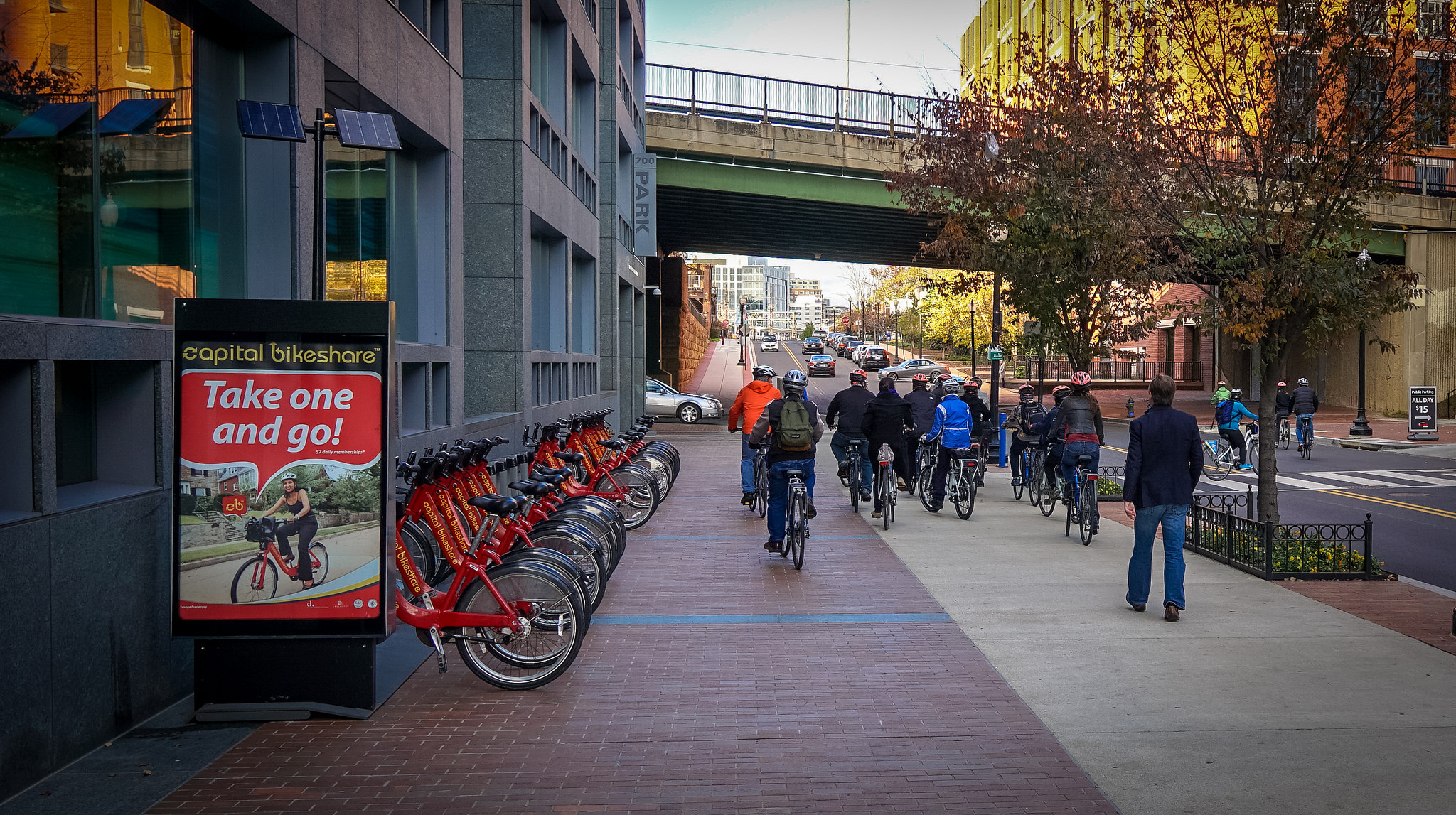D.C. is still a pioneer in bikesharing, but more must be done for it to be a part of families’ car-free transportation options
Capital Bikeshare was one of the first successful bikesharing systems set up in the United States, and is still one of the largest systems in the country. Now the system has added electric bicycles for the first time as dockless bike and (especially) scooter sharing has grown over the past year.
Throughout this process, a lot of thought has been given to how accessible bikesharing is, and how to ensure that bikesharing is equitable for people of all races and incomes in a city where the two are closely correlated. Early efforts sought to provide access across every ward and for every neighborhood, and to help people without bank accounts or credit cards sign up for memberships, although more remains to be done.
There have also been increasing discussions about how to make bikeshare more accessible to people with different physical needs. The introduction of e-bikes has expanded access to people of varying abilities, such as some older riders, according to AARP. Other cities’ bikeshare systems have introduced tricycles and recumbent bicycles to make their programs more accessible to riders with disabilities. Zagster, which operates College Park’s Mbike program, does offer a range of bicycles, including handcycles (where you pedal with your arms) and tricycles (less balancing required) in other cities, but not for Mbike itself.
While many of these accessibility efforts are still limited in scope or in a pilot stage, another remaining challenge that few cities have addressed at all is family biking. Roughly one in five households in D.C. (20 percent) have children under the age of 18, including more than a third of households in Ward 7 (34 percent) and Ward 8 (38 percent).
Some parents and caregivers already incorporate bikeshare into the leg of their commute that takes place between work and school, for instance, but logistical challenges mean that other families in D.C. may not be able to access bikesharing as a car-free transportation option in their daily routines. With a broader goal of having 25 percent of trips be accomplished by foot or by bicycle by 2032, the city needs to do more to encourage family biking—both to bring on new bike commuters and to ensure current cyclists can continue as their families’ transportation needs change over time.
Potential barriers to family-friendly bikeshare
Depending on the age of the children, family biking could involve one family using several bicycles together, or one or more adults biking with smaller children strapped into a seat, trailer or other accessory. However, most bikeshare systems are not set up to enable or encourage this kid of use, whether due to explicit age restrictions, lack of appropriately-sized bikes or accessories, or general logistical constraints.
One of the first challenges to family-friendly bikesharing in D.C. is that Capital Bikeshare explicitly prohibits riders under the age of 16 (though in practice, it seems that almost anyone who can fit on the bikes can be seen riding them regardless of age.)[1] Beyond that, however, the system is still not set up for riding with younger children who may not be ready for riding a bike on their own.
When children are too young to bike on their own, they usually sit in a bike seat mounted on a full-sized bike, or they can sit in a trailer or cargo bike attachment (while wearing a helmet throughout). While it may be a little onerous to carry a bike seat to a bikeshare station, some parents may be willing to—but the bikeshare system may not let them. In 2014, when a parent fashioned their own mounted seat for Capital Bikeshare, the system came down hard on the inventor and has since publicly declined to explore the possibility of adding seats and trailers to allow smaller riders.
Still, 16 is a lower age limit than the city’s dockless bikeshare operators, which default to 18 for their users. But dockless options have contracted over the past year, with some companies pulling out altogether while others have switched to more profitable electric scooters (which also are not set up for transporting young children.)
So what options are there for families? Is there room to allow for bikeshare with options to include bicycles fitted with seats or trailers to bring the kids along?
What family-friendly bikeshare options exist?
Bikeshare systems that offer anything a child could ride along in are rare, and nearly all in Europe. Moreover, all the systems I was able to confirm were either very small or pilot programs. There the focus is on cargo bikes, which can transport kids (or groceries or even another adult) but may lack the safety restraints preferred for smaller children.
- The largest cargo bikeshare is Carvelo2go, a dockless program that operates across several Swiss Cities. but its website shows just a few bikes in each city and nothing at the scale of even the small cap of 400 bike for dockless companies. Fewer than 100 bikes total seems to be the most any one city has in any cargo bikeshare scheme, including the TINK program (which uses around 60 bikes across two cities in Germany.)
- The mayor of Paris, France recently announced that the city’s Vélib bikeshare system will be free for young people under the age of 18, although the system does not allow children under the age of 14. Paris made headlines in 2014 for offering a “P’tit Vélib’” option with smaller bikes for young children, although the program appears to have ended by 2017.
- The city of Fortaleza in Brazil added smaller bicycle sharing stations with retractable training wheels. Known as “mini-bicicletar” in Portuguese, the system works the same as the regular-sized system in the city, except that the docks are only a few feet high. The system is also quite limited, with only 5 stations and 50 bikes available.

Smaller “mini-bicicletar” bikeshare option in Fortaleza, Brazil with retractable training wheels. Photo Credit: Prefeitura de Fortaleza
- Domestically, there is Detroit’s Mogo bikeshare, which is piloting a program that would allow some adaptive bikes, including cargo bikes—but in addition to being a limited pilot program, users must reserve bikes beforehand and go to a central facility to pick up the bike. (Some private bike rental companies (notably Bike and Roll with multiple rental locations across the region) in D.C. also provide trailers or tandem ride-alongs, but these are outside of the bikesharing model.)
- In New York City there is a Cargo Bike Collective which is a community-based option for borrowing cargo bikes, but the model might be better suited for occasional use rather than the heavy usage successful bikeshare programs typically see.
The District could simply adopt any of these approaches and move forward with family bikesharing in some aspects (more on that in a moment), but there are still some considerations when it comes to family biking that go beyond the mechanics of a bikesharing system.
More than trailers: What is needed to make bikeshare family-friendly
It would take more than accessories like an extra seat or a trailer to make CaBi family friendly. To begin with, CaBi’s user terms would need to be updated to allow for riders or passengers younger than 16. The same applies to any current dockless companies who may be encouraged to add trailer or child seat options. And resistance may come not only from the operators themselves—the insurance companies who underwrite the corporate policies may balk at the prospect of adding younger riders as well.
Then there are infrastructure concerns. During CaBi’s initial rollout, the size and presence of docks caused occasional controversy and led to some modifications or cancellations of planned stations.[2] More recently, dockless bike and scooter companies have struggled to find ways to encourage users to park where sidewalk access is not otherwise blocked, as the District has not set aside space on sidewalks or streets for dockless parking. These issues would be magnified with the bigger bikes or accessories needed for families. Without real commitments to providing more parking for bikes on city streets sized to accommodate larger bikes suitable for families, or new stations for smaller bikes like in Fortaleza, it will be difficult to accommodate family biking with so little space to work with.
Cost is another factor. Retail prices for cargo bikes start high and stay there mostly because of the cost of extra materials and the smaller market for the product. For a bikeshare system these costs may be magnified depending on specifications. CaBi bikes cost about $1,000 apiece in 2011 when Alexandria was first considering joining the system. That is before the cost of docks or other capital costs.
The city would also need to make some decisions about its helmet laws. Currently bike riders under the age of 16 are required to wear a helmet when riding a bicycle (or scooter or skateboard), and while bikeshare systems give away helmets on occasion the requirement would need to be examined in light of how to reconcile it with a program that lets parents put their kids on a bicycle on the fly.
If the city were to endorse some sort of cargo bike option, it would need to think about whether or not the city should require constraints or other safety features beyond a helmet as well. That can add cost and complexity to any designs for the bikes and how users interact with a new system.
Becoming a leader in family-friendly bikeshare
D.C. may decide that the logistical challenges are worth the improvements in accessibility to implement family friendly bikesharing using one of the existing models. Despite their modest sizes, the cargo bikeshare systems in Europe could begin operating here and fit well under the current dockless caps implemented in the city if any were looking to expand in the U.S. Or D.C. could bring the concept of the mini-bicicletar north and put some mini-bikes in certain places around the city, especially close to trails or streets conducive to family-friendly riding.
There may also be other ways to improve family biking besides relying on bikesharing by making the city more bike-friendly in general. One of the first ways would be for the city to identify more streets for protected bike lanes and speed up the construction of bike lanes across the city. That would encourage more riding overall, especially among parents and caregivers who may be especially concerned about the safety of biking on city streets without protected lanes. (For more ways to make D.C. more bike-friendly, see Erin Potter’s article on bridging the gender gap in cycling, Veronica Davis’s efforts to get more women of color on bikes, and Dr. Anne Lusk’s recent article on bike equity.)

The city could also look into helping families with the purchase of cargo bikes directly. DDOT spent $250,000 on almost 1000 bikes for its program to teach DCPS second-graders how to bike. That same amount of money wouldn’t buy as many bikes built for family biking, but we have already seen that most cargo bike-based systems that exist today are very small, usually offering fewer than 100 bikes in total.
By simply giving cargo bikes, away the city could possibly get similar ridership to a sharing system if all the families use the bikes more than occasionally.[3] Such a program could work in tandem with other bicycling equity programs that Capital Bikeshare or DDOT are already undertaking like reaching out to underbanked communities or elementary school programs. The start-up costs for such a pilot at least would not be more expensive than a similar pilot with any bikesharing company that might have cargo options today. A program focused on families in all eight wards at all income levels could provide a large dataset for future study while a focused study in one ward in one particular demographic may bring about the largest changes overall.
Washington, D.C. has already proven itself a leader in bikesharing, but making our bikesharing options accessible to all residents means addressing the barriers that can prevent families from participating. As a whole the industry does not yet seem entirely ready for a family biking revolution, but we can build on the preliminary steps that have already been taken and make D.C. a leader in family-friendly bikeshare—and family-friendly biking in general.
Feature photo by Ted Eytan (Source)
Canaan Merchant is a graduate of George Mason University. He has a passion for public transportation and urban planning and writes frequently for Greater Greater Washington. Canaan has worked for a variety of federal agencies including the U.S. Treasury, Consumer Financial Protection Bureau, Department of Transportation, and Homeland Security.
Notes
[1] This doesn’t mean that Washington itself is averse to the idea of kids riding bikes. DC Public Schools originally partnered with the Washington Area Bicyclist Association (WABA) to teach second graders how to ride a bike and now that program is part of the second grade PE curriculum.
[2] Examples include complaints in Lincoln Park, Georgetown, and the National Mall, although some of these stations were eventually built.
[3] One challenge then would be identifying families for the pilot, as they would need to have the space to store one at home and elsewhere; even with a limited rollout, this could be used to pilot programs to expose more people to biking with the kids. The program would also require follow up to see whether or not families used the bikes, what challenges they still experienced, and to what extent their habits changed.
